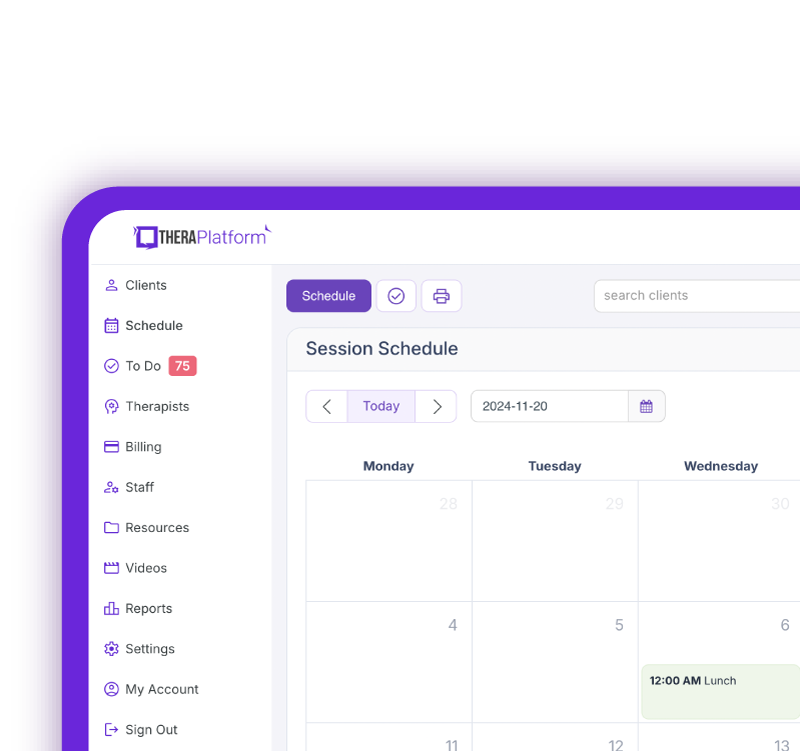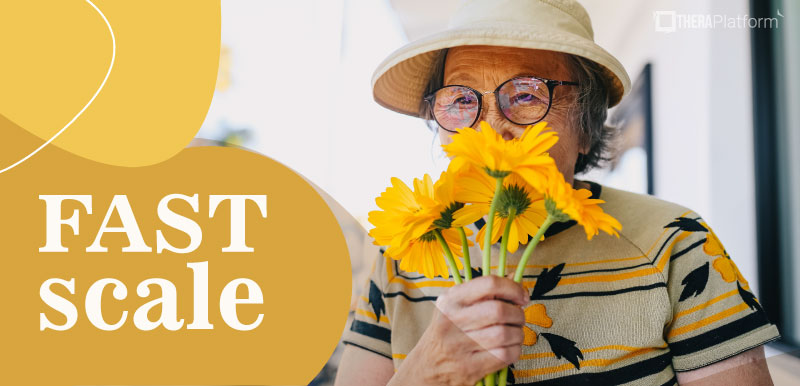
Ayers Sensory Integration was developed in the 1960s by Dr. A. Jean Ayres, an occupational therapist and educational psychologist, who reshaped how we understand children’s development.
Summary
- Developed in the 1960s, ASI is an evidence-based practice that helps children with autism, ADHD, and learning challenges improve regulation, function, and participation.
- Sensory integration is how the brain organizes and responds to input from multiple systems (touch, movement, vision, hearing, etc.). Disruptions can affect daily life, learning, and social skills.
- Tools like the Sensory Profile, SPM, and SIPT—combined with observation—guide individualized, play-based interventions that support neuroplasticity and functional goals. Using an EHR like TheraPlatform can help therapists document their assessments.
- Structured activities (e.g., deep pressure, movement breaks) embedded into routines help children regulate, with consistent support across home, school, and therapy. Download my free brain breaks list now.
Streamline your practice with One EHR
- Scheduling
- Flexible notes
- Template library
- Billing & payments
- Insurance claims
- Client portal
- Telehealth
- E-fax

Drawing on neuroscience and clinical observation, the Ayres Sensory Integration (ASI), has long been considered a groundbreaking theory and intervention model.
Originally shown to be effective with children experiencing learning and behavioral challenges, ASI has since grown into an evidence-based practice for children with autism and related conditions.
More than six decades of clinical practice and research continue to refine and expand Ayers Sensory Integration, solidifying its role as both a foundational framework in occupational therapy and a dynamic, evolving approach for addressing sensory and functional challenges.
What is sensory integration?
Sensory integration is the neurological process that allows us to receive, organize, and interpret information from our surroundings. This information comes through multiple sensory systems, including auditory (hearing), visual (sight), tactile (touch), olfactory (smell), gustatory (taste), proprioception (body position), vestibular (movement and balance), and interoception (internal body signals).
Once the brain processes this input, it identifies what the information means and generates an appropriate adaptive response, a purposeful action that helps us interact effectively with our environment.
This process is essential for everyday life. The way we take in and integrate sensory input directly shapes our physical coordination, cognitive functioning, emotional regulation, and social participation.
When sensory processing works smoothly, individuals can focus, engage, and respond with flexibility. When it is disrupted, daily routines and overall well-being can be significantly affected.
Practice Management + EHR + Telehealth
Manage more in less time in your practice with TheraPlatform

What are sensory processing challenges?
Sensory Processing Disorder (SPD) is described as difficulty detecting, modulating, or interpreting sensory input. While not officially a diagnostic category in the DSM-5, SPD is widely recognized in clinical practice.
Core patterns of sensory challenges include:
- Over-responsivity: Intense reactions to everyday sensations (covering ears for normal sounds).
- Under-responsivity: Diminished awareness or delayed responses to sensory input (not noticing name being called).
- Sensory seeking: Craving sensory input through movement, pressure, or sound (spinning, crashing into objects).
Functional impacts are diverse and can affect self-care, feeding, play, social skills, and learning. Signs and severity vary by individual.
Subtypes of sensory challenges often Involve:
- Tactile: Sensitivity to textures, messy play, or grooming.
- Vestibular: Fear of movement vs. constant spinning/jumping.
- Proprioceptive: Clumsiness, crashing, or heavy work seeking.
- Auditory: Sensitivity to background noise vs. constant humming.
- Visual: Avoiding bright lights vs. enjoying moving patterns.
Sensory processing challenges are often closely tied to difficulties with emotional regulation and motor planning, and they are frequently observed in children with autism, ADHD, and various learning delays.
These behaviors are often first noticed by parents, caregivers, or teachers during everyday routines. The signs and behaviors listed here are not all-inclusive. Every child processes sensory input in their own way, and responses may look very different from one child to another.
Common Signs and Symptoms of SPD:
Sensory avoidance | Sensory seeking | |
|---|---|---|
Tactile | Avoids clothing or foods of certain textures Does not like to get messy Difficulty with grooming | Constant touching Seeking out touch sensations |
Vestibular | Avoids playground equipment Likes sedentary play Fearful of being on moving equipment Very cautious of movement activities | Seeks out excessive movement and enjoys: Spinning Swinging Rocking |
Visual | Sensitive to bright lights Sensitive to busy environments | Attracted to bright lights, colors, or moving objects |
Auditory | Overreaction or distress with loud noises Covers ears | Seek out loud noises, repetitive sounds Enjoys activities that make lots of sounds or noises |
Proprioceptive | Seeks out deep pressure Likes tight hugs Crashing Jumping Difficulty with force-gradation |
Ayres Sensory Integration assessment tools and evaluation methods
Ayres Sensory Integration (ASI) uses a combination of standardized tools and observation to evaluate how individuals process sensory input.
The most common assessments include the Sensory Profile (SP), the Sensory Processing Measure (SPM), and the Sensory Integration and Praxis Test (SIPT), along with skilled observation during structured play and teacher or caregiver reports. Together, these methods provide a comprehensive view of sensory strengths, challenges, and their impact across home, school, and community settings.
Tool | Age Range | Format | Setting | Measures |
|---|---|---|---|---|
Birth–14 years 11 months | Caregiver/teacher questionnaire | Home, school, and community-based activities | Sensory patterns (seeking, avoiding, sensitivity, low registration) and impact on daily life | |
Sensory Processing Measure 2 (SPM 2) | 4 months - 87 years old | Caregiver/teacher questionnaire | Home and school | Descriptive clinical information on processing vulnerabilities within each sensory system, including under- and over-reactivity, sensory-seeking behavior, and difficulties with perception. |
Sensory Integration Praxis Test (SIPT) | 4 years 8 months - 8 years 11 months | Performance-based tasks | Clinical setting | Tactile, vestibular, proprioceptive, and visual processing; motor planning and bilateral integration |
Skilled Clinical Observations | All ages | Structured play and activity-based observation | Clinic, school, home | Real-time sensory responses, seeking/avoidance behaviors, regulation, and functional participation |
How ASI works: Intervention principles
Ayres Sensory Integration is built on several principles:
- Individualized: Client-centered planning based on assessment.
- Neuroplasticity: Purposeful activity changes the brain.
- Play-based: Motivating activities that elicit adaptive responses.
- Focus on Function: Improved self-care, social skills, school participation, and play.
Sample Ayres Sensory Integration goals for OT intervention
Tactile goal
Client will tolerate hair washing by completing at least 50% of the routine without distress or adverse behaviors, in 3 out of 5 opportunities per week, to increase independence and participation in activities of daily living (ADLs).
Emotional regulation goal
Client will independently select and use a preferred self-regulation strategy (e.g., deep breathing, fidget tool, movement break) with no more than 2 prompts, in 3 out of 4 opportunities, as measured by OT data collection and observation, to support successful transitions and participation.
Motor planning goal
Client will independently complete a multi-step obstacle course (e.g., balance beam, ramp, stairs, climbing equipment) in 4 out of 5 opportunities, demonstrating age-appropriate balance, sequencing, and motor planning skills needed for playground and classroom activities.
Attention goal
With access to individualized sensory strategies, the client will maintain attention and participate appropriately during circle time at school in 4 out of 5 opportunities per week, without aggression toward peers, as reported by the teacher and confirmed through OT observation.
Documenting Sensory Integration Therapy
Proper documentation is essential not only for continuity of care but also for insurance compliance and progress tracking.
When working with sensory integration, your notes should capture sensory processing challenges, specific interventions used (such as proprioceptive input or vestibular activities), the client's responses, and progress toward goals.
Here's an example of how you might structure a SOAP note for a sensory integration session:
Example SOAP Note for Sensory Integration
- S (Subjective): Client stated, "I don’t like the swing; it makes me feel weird." Parent reports difficulty with dressing due to sensitivity to certain textures.
- O (Objective): Client participated in a 45-minute session. Engaged in 10 minutes of proprioceptive input (weighted blanket and wheelbarrow walking), followed by 15 minutes of vestibular input using a platform swing. Demonstrated increased tolerance to movement by end of session.
- A (Assessment): Client is showing gradual improvement in vestibular tolerance. Continued sensory-based interventions are supporting regulation.
- P (Plan): Continue sensory integration activities with a focus on proprioceptive input before vestibular tasks. Educate parent on at-home sensory diet strategies.
Bonus: Tips for Streamlining Documentation
Efficient documentation is a common challenge for many occupational therapists. If you’re looking to save time while still writing effective notes, check out this helpful video:
Watch this video to learn how to save time on therapy notes
→ Start My Free Trial Now
Sensory diets and routines
A sensory diet is a customized plan of activities providing the right input at the right time to support regulation.
Who benefits? Children with SPD, ASD, ADHD, or regulation challenges.
Examples
- Calming: Deep pressure, weighted blanket, slow swinging.
- Alerting: Jumping jacks, crunchy foods, upbeat music.
Embedding into routines:
- Morning: Trampoline jumping before school.
- Mid-day: Chewy snacks or heavy work in the classroom.
- Evening: Warm bath, massage, dim lights before bed.
Regular monitoring, collaboration, and consistency amongst educators and caregivers is key to adjusting based on the ever-changing needs of an individual.
Pros and Cons of Ayres Sensory Integration:
Pros
- Holistic, individualized, child-centered.
- Backed by decades of theory and growing evidence.
- Encourages caregiver involvement.
- Improves daily function and regulation.
Cons
- Requires advanced OT training/certification.
- Progress may be gradual and variable.
- Not appropriate for every client.
- Limited access in underserved areas.
Free Resources for Therapists
Click below and help yourself to peer-created resources:

Training and credentialing for Ayres Sensory Integration
To become certified in Ayres Sensory Integration (ASI), occupational therapists must complete specialized post-professional training through recognized programs such as:
- STAR Institute,
- USC/WPS SIPT training
- ASI Wise, or
- ICEASI certification
These programs combine theoretical instruction, hands-on mentorship, and supervised practice to ensure therapists can deliver ASI with fidelity. Proper credentialing equips OTs with the clinical reasoning and skills necessary for effective intervention, distinguishing true ASI from general sensory-based activities.
Research and evidence behind Ayres Sensory Integration
Systematic reviews indicate that positive outcomes are most consistently observed when Ayres Sensory Integration (ASI) is delivered with fidelity, adhering closely to the core principles and individualized intervention strategies.
Evidence states that "Ayres Sensory Integration intervention is one of the most frequently requested and highly utilized interventions in autism” however, therapists must provide ASI intervention that adheres to the essential elements of this intervention to ensure that the intervention delivered is in keeping with an evidence-based practice.
“The research also points to the need to address differences in outcomes, as well as the lack of success in some studies on the clinical benefits of sensory integration therapy.” (Carmino-Alcron, et al., 2024)
“Most of these studies were conducted from a clinical perspective, which makes new research necessary on intervention with sensory integration from other ecological environments that are part of the daily lives of children with ASD, such as the home and school.” (Carmino-Alcron, et al., 2024)
All in all, ongoing research continues to refine best practices and enhance the effectiveness of sensory integration interventions.
Ayres Sensory Integration empowers children by addressing sensory challenges that affect learning, regulation, and social connection. With skilled assessment, individualized support, and caregiver collaboration, ASI can help every child move closer to their fullest potential.
Streamline your practice with One EHR
- Scheduling
- Flexible notes
- Template library
- Billing & payments
- Insurance claims
- Client portal
- Telehealth
- E-fax

Resources
TheraPlatform is an all-in-one EHR, practice management, and teletherapy software built for therapists to help them save time on admin tasks. It offers a 30-day risk-free trial with no credit card required and supports different industries and sizes of practices, including occupational therapists in group and solo practices.
More resources
- Therapy resources and worksheets
- Therapy private practice courses
- Ultimate teletherapy ebook
- The Ultimate Insurance Billing Guide for Therapists
- The Ultimate Guide to Starting a Private Therapy Practice
- Mental health credentialing
- Insurance billing 101
- Practice management tools
- Behavioral Health tools
Free video classes
- Free on-demand insurance billing for therapist course
- Free mini video lessons to enhance your private practice
- 9 Admin tasks to automate in your private practice
References
- (SIPT) Sensory Integration and Praxis Tests. Educational & Psychological Assessments for Clinicians & Educators. https://www.wpspublish.com/sipt-sensory-integration-and-praxis-tests
- (SPM-2) Sensory Processing Measure, Second Edition and SPM-2 Quick Tips. (SPM-2) https://www.wpspublish.com/spm-2
- About ASI: Ayres Sensory Integration. The Collaborative For Leadership In Ayres Sensory Integration. https://www.cl-asi.org/about-ayres-sensory-integration
- Camino-Alarcón, J., Robles-Bello, M. A., Valencia-Naranjo, N., & Sarhani-Robles, A. (2024). A systematic review of treatment for children with autism spectrum disorder: The sensory processing and sensory integration approach. Children, 11(10), 1222. https://doi.org/10.3390/children11101222
- Schoen, S. A., Lane, S. J., Mailloux, Z., May‐Benson, T., Parham, L. D., Smith Roley, S., & Schaaf, R. C. (2018). A systematic review of Ayres sensory integration intervention for children with autism. Autism Research, 12(1), 6–19. https://doi.org/10.1002/aur.2046
- Sensory profile 2. Sensory Profile 2 | Pearson Assessments US. https://www.pearsonassessments.com/en-us/Store/Professional-Assessments/Motor-Sensory/Sensory-Profile-2/p/100000822?srsltid=AfmBOorME2bb4SSVgOUYYunbqsrgeHM SJFHAVUmVgrKyPjpDmZsAqFT5
FAQs about Ayres Sensory Integration
What is Ayres Sensory Integration (ASI)?
ASI is an evidence-based occupational therapy approach developed by Dr. A. Jean Ayres that helps children process and respond to sensory input, improving regulation, learning, and participation in daily activities.
How do therapists assess sensory processing challenges?
Therapists use standardized tools such as the Sensory Profile, Sensory Processing Measure (SPM), and Sensory Integration and Praxis Test (SIPT), along with skilled clinical observation and caregiver input.
Who can benefit from Ayres Sensory Integration?
Children with autism, ADHD, learning delays, or sensory processing difficulties often benefit, especially when therapy is individualized, play-based, and supported by caregivers across home, school, and community settings.



